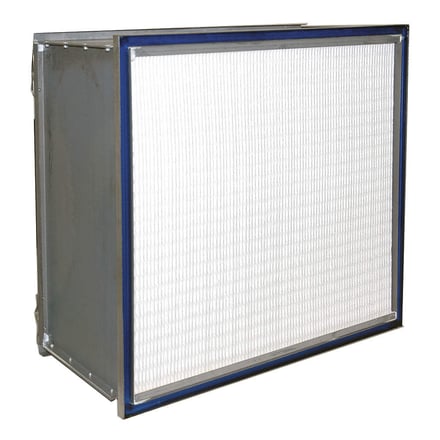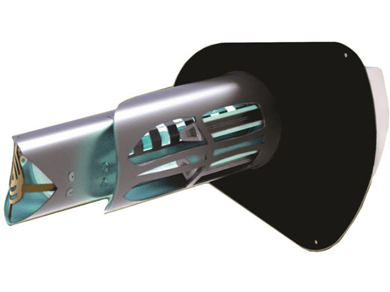If you recall the earliest days of coronavirus awareness, you might remember worrying more about washing your hands than wearing a mask. Back then, scientists thought that the virus was transferred mainly from surface to surface. However, as more research is conducted each week, we get a clearer and more accurate picture of how to best control this pandemic. One critical fact we’ve learned this year is how COVID-19 spreads through the air via airborne droplets from an infected person.
This information is what implies the importance of wearing masks and social distancing. Masks can drastically decrease the number of droplets that escape into the air from a person’s breath or speech. Social distancing puts space between people and, therefore, the potential of encountering infected droplets in the air.
But what about those instances when you can’t control social distance, like in school or at work? Many people have decided to return to shared, indoor spaces where fresh air and extra space are not necessarily an option. In these cases, air purification is vital in keeping air flowing and reducing the presence of COVID-19 in an area.
What you need to know about COVID-19 and air
When it comes to taking precautions against COVID-19, indoor spaces require more steps than outdoor spaces. In both cases, the CDC emphasizes the importance of social distancing and wearing masks. The third element that contributes to protection against spreading the virus is ventilation and airflow.
Outdoor social gatherings have been a safe choice not just because of the option for extra spacing but because of the good airflow that’s present when outside. When you’re inside of a space with poor ventilation, the air lingers in the space, and potentially so does the virus. There is now evidence that the virus can be transmitted by airborne particles in an enclosed area. The smaller the room and the more people, the more the particles will hang around.
Think of it like cigarette smoke. As a greater number of people smoke in a small space, more and more smoke will linger, filling the air. But, if ventilation increases, the smoke is swept away.
Enhancing the ventilation and air purification of a space can be a big help in reducing the risk of airborne transmission. Although it should still be paired with other precautions, like masks, hand washing, and social distancing, the EPA does recommend using good ventilation and an air cleaning system to treat indoor air.
If you are looking to improve air quality either in your home or in another indoor space you occupy, Geiler can help.
We have over 130 years of experience and know all the ins and outs of indoor air purification. We can help you set up the right system for the space to help you reduce the risk of contracting or spreading COVID-19.
Here’s some of what you should look for in an air purifier, as well as ways to use your HVAC system for cleaner air.
HEPA filters
A pandemic is no time to cut corners. You need an air purifier that is made with high-efficiency particulate absorption (HEPA) filters. As their name suggests, HEPA filters are the most efficient filters on the market. They can trap more particles than other types of filters, including particles as tiny as just 0.3 microns in diameter. The majority of HEPA filters can remove 100% of the air pollutants that come into contact with them. Those are the kind of odds you want when choosing an air purifier to help reduce the presence of COVID-19!
Scientists recommend using air cleaners with HEPA filters to supplement a space’s air purification. HEPA filters are ideal for their ability to remove almost every particle, no matter the size, in just one pass.
Selecting the Right Air Purifier for Your Home
Clean Air Delivery Rate
The Clean Air Delivery Rate rating system marks another way to judge an air cleaner’s performance. This number will reveal how much air is getting cleaned. The CADR displays the volume of air that the air purifier is cleaning in cubic feet per minute measurement or CFM. Checking on a purifier’s CADR will give you an idea of how well that unit is performing and how much air it’s capable of cleaning at a time.
In order to get its CADR, an air purifier is tested by the manufacturer for its ability to remove several different types of particles: smoke, dust, and pollen. These three particles represent three different sizes of particles. Each size of a particle gets its own CADR score.
The CADR takes into consideration both airflow as well as the efficiency of the air filter. Since both of these are crucial in reducing the presence of airborne COVID-19 particles, finding a filter with a high CADR rating for all particle sizes is a must.
Cleaner Indoor Air
Improving your HVAC filtration
Since good ventilation isn’t always possible in every indoor space, filtering the recycled air is essential. We’ve discussed using portable air purifiers as a way of treating small spaces, but updating the filters in a full HVAC system might be the right step to take for full residential or commercial spaces.
The efficiency of HVAC systems is measured using something called MERV, or minimum efficiency reporting value. The MERV rating tells you how well a filter can collect particles in different sizes in the first pass. Higher numbers mean better filtration.
Before the coronavirus pandemic, a MERV-8 filter was perfectly acceptable. These are designed to allow for a faster airflow, but their design also allows them to miss 60% of the 1-micron size particles. That’s not good enough when you’re treating the air to clear out the coronavirus.
A better filter option for an HVAC system would be a MERV-13. This type of filter traps at least 85% of 1-micron particles, which makes it more than twice as likely to filter out airborne coronavirus particles.
We all want the safest and surest options for ourselves and our families right now. For some of us, that might mean creating a cleaner airflow. Geiler is happy to be an expert in doing just that.
Check out our Indoor Air Quality page.



